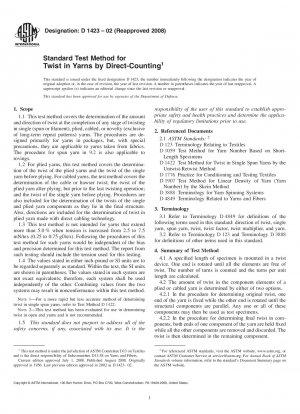ASTM D1423-02(2008)
Standard Test Method for Twist in Yarns by Direct-Counting
- Standard No.
- ASTM D1423-02(2008)
- Release Date
- 2002
- Published By
- American Society for Testing and Materials (ASTM)
- Status
- Replace By
- ASTM D1423/D1423M-16
- Latest
- ASTM D1423/D1423M-16(2022)
- Scope
Test Method D 1423 for testing twist in yarns by direct-counting is considered satisfactory for acceptance testing of commercial shipments because current estimates of between-laboratory precision are acceptable and the method has been used extensively in the trade for acceptance testing.
If there are differences of practical significance between reported test results for two laboratories (or more), comparative tests should be performed to determine if there is a statistical bias between them, using competent statistical assistance. As a minimum use the samples for such comparative tests as homogeneous as possible, drawn from the same lot of material that resulted in the disparate test results and randomly in equal numbers to each laboratory. The test results from the laboratories involved should be compared using a statistical test for unpaired data, at a probability level chosen prior to the testing series. If a bias is found, either its cause must be found and corrected, or future test results for that material must be adjusted in consideration of the known bias.
The determination of twist in a straight section of a yarn is not the simple straightforward operation it appears to be, for the test results may be greatly influenced by variations in test procedures and techniques. In all manipulations, extreme care is necessary to prevent specimen rotation altering the twist level before testing begins.
The twist in a yarn before it is packaged may be different from that of the yarn after it has been withdrawn from the package because of changes in tension and the effect of the method of withdrawal. If the yarn is withdrawn over-end, a slight increase or decrease in twist will take place, depending upon the direction of the twist in the yarn, the direction of winding on the package, and the length of the wrap on the package.
When a yarn is incorporated into or removed from a more complex structure, alterations may occur as a result of the plying, untwisting, or raveling operation. For example, when determining the twist in plied yarn by the procedure for determining original twist, as the plied yarn is untwisted, a comparable amount of twist is reinserted in, or removed from, the single-yarn components. As a consequence, the single yarns have approximately the original twist prior to the plying operation but not the twist they have when they are functioning as components of the plied yarn. The latter or final twist may be estimated by adding the ply twist to (or subtracting it from) the single-yarn twist depending on the directions of the ply and singles twist. For a more precise determination, the test procedure must be modified. There are thus two different procedures for preparing specimens of the component elements of a plied or cabled yarn for twist determination. The procedure for the original twist measures the twist in a component of a complex strand after the components have been untwisted. The procedure for final twist measures the twist in a component as it lies in the complex strand. Although the original twist procedure is most often used, selection of a particular procedure will depend on the type of information needed.
Note 38212;The difference in twist between unwinding from the side and over-end is 1/πd, where d is the diameter of the package. Thus, for a 25-mm (1-in.) diameter package, the difference would be about 13 tpm or about 1/3 tpi.
When a yarn is taken from a more complex yarn structure or from a fabric, the resultant twist should be considered only an approximation of the original value because of alterations that may have occurred as a result of the effects of unwinding, handling, and mechanical strains met in processing.
The optimum amount of twist depends upon ........
ASTM D1423-02(2008) Referenced Document
- ASTM D1059 Standard Test Method for Yarn Number Based on Short-Length Specimens
- ASTM D123 Standard Terminology Relating to Textiles
- ASTM D1422 Standard Test Method for Twist in Single Spun Yarns by the Untwist-Retwist Method
- ASTM D1776 Standard Practice for Conditioning and Testing Textiles
- ASTM D1907 Standard Test Method for Linear Density of Yarn (Yarn Number) by the Skein Method
- ASTM D3888 Standard Terminology Relating to Open-End Spinning
- ASTM D4849 Standard Terminology Related to Yarns and Fibers
ASTM D1423-02(2008) history
- 2022 ASTM D1423/D1423M-16(2022) Standard Test Method for Twist in Yarns by Direct-Counting
- 2016 ASTM D1423/D1423M-16 Standard Test Method for Twist in Yarns by Direct-Counting
- 2002 ASTM D1423-02(2008) Standard Test Method for Twist in Yarns by Direct-Counting
- 2002 ASTM D1423-02 Standard Test Method for Twist in Yarns by Direct-Counting
- 1999 ASTM D1423-99 Standard Test Method for Twist in Yarns by Direct-Counting
